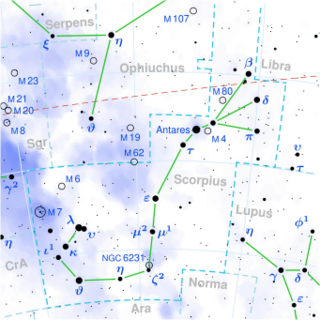Astronomy:Gliese 682
Coordinates: ![]() 17h 37m 03.6613s, −44° 19′ 09.18″
17h 37m 03.6613s, −44° 19′ 09.18″
Location of Gliese 682 in the constellation Scorpius | |
| Observation data Equinox J2000.0]] (ICRS) | |
|---|---|
| Constellation | Scorpius |
| Right ascension | 17h 37m 03.6655s[1] |
| Declination | −44° 19′ 09.166″[1] |
| Apparent magnitude (V) | 10.94[2] |
| Characteristics | |
| Spectral type | M3.5V[3] |
| Apparent magnitude (B) | ~12.61[4] |
| Apparent magnitude (V) | ~10.96[4] |
| Apparent magnitude (J) | 6.544 ±0.023[4] |
| Apparent magnitude (H) | 5.917 ±0.038[4] |
| Apparent magnitude (K) | 5.606 ±0.020[4] |
| Astrometry | |
| Radial velocity (Rv) | −34.90±0.30[1] km/s |
| Proper motion (μ) | RA: −705.945±0.035[1] mas/yr Dec.: −938.080±0.021[1] mas/yr |
| Parallax (π) | 199.6944 ± 0.0312[1] mas |
| Distance | 16.333 ± 0.003 ly (5.0077 ± 0.0008 pc) |
| Absolute magnitude (MV) | 12.4[5] |
| Details | |
| Mass | 0.27[3] M☉ |
| Radius | 0.30[2] R☉ |
| Luminosity | 0.008118[3] L☉ |
| Surface gravity (log g) | 4.95[6] cgs |
| Temperature | 3,237[2] K |
| Metallicity [Fe/H] | 0.05±0.09[6] dex |
| Rotational velocity (v sin i) | 3.42[7] km/s |
| Age | 6.4±4.3[6] Gyr |
| Other designations | |
CD−44 11909, GJ 682, LHS 451, LFT 1358, HIP 86214, PLX 3992. | |
| Database references | |
| SIMBAD | star |
| planet b | |
| planet c | |
| Exoplanet Archive | data |
| ARICNS | data |
| Extrasolar Planets Encyclopaedia | data |
Gliese 682 or GJ 682 is a red dwarf. It is listed as the 53rd-nearest known star system to the Sun,[8] being 16.3 light years away from the Earth. Even though it is close by, it is dim with a magnitude of 10.95 and thus requires a telescope to be seen. It is located in the constellation of Scorpius, near the bright star Theta Scorpii.[4] The star is in a crowded region of sky near the Galactic Center, and so appears to be near a number of deep-sky objects from the Solar System's perspective. The star is only 0.5 degrees from the much more distant globular cluster NGC 6388.
Search for planets
| Companion (in order from star) |
Mass | Semimajor axis (AU) |
Orbital period (days) |
Eccentricity | Inclination | Radius |
|---|---|---|---|---|---|---|
| b (unconfirmed) | >4.4 M⊕ | 0.08 | 17.48 | 0.08 | — | — |
| c (unconfirmed) | >8.7 M⊕ | 0.18 | 57.32 | 0.10 | — | — |
Two candidate planets were detected orbiting Gliese 682 in 2014, one of which would be in the habitable zone.[9][10] However, a 2020 study did not find these planets and concluded that the radial velocity signals were probably caused by stellar activity.[11]
See also
References
- ↑ 1.0 1.1 1.2 1.3 1.4 Vallenari, A. et al. (2022). "Gaia Data Release 3. Summary of the content and survey properties". Astronomy & Astrophysics. doi:10.1051/0004-6361/202243940 Gaia DR3 record for this source at VizieR.
- ↑ 2.0 2.1 2.2 Suissa, Gabrielle; Mandell, Avi M.; Wolf, Eric T.; Villanueva, Geronimo L.; Fauchez, Thomas; Kopparapu, Ravi Kumar (2020). "Dim Prospects for Transmission Spectra of Ocean Earths around M Stars". The Astrophysical Journal 891 (1): 58. doi:10.3847/1538-4357/ab72f9. Bibcode: 2020ApJ...891...58S.
- ↑ 3.0 3.1 3.2 Martínez-Rodríguez, Héctor; Caballero, José Antonio; Cifuentes, Carlos; Piro, Anthony L.; Barnes, Rory (2019). "Exomoons in the Habitable Zones of M Dwarfs". The Astrophysical Journal 887 (2): 261. doi:10.3847/1538-4357/ab5640. Bibcode: 2019ApJ...887..261M.
- ↑ 4.0 4.1 4.2 4.3 4.4 4.5 "LHS 451 -- High proper-motion Star". Centre de Données astronomiques de Strasbourg. http://simbad.u-strasbg.fr/simbad/sim-id?Ident=GJ+682.
- ↑ Boro Saikia, S.; Marvin, C. J.; Jeffers, S. V.; Reiners, A.; Cameron, R.; Marsden, S. C.; Petit, P.; Warnecke, J. et al. (2018). "Chromospheric activity catalogue of 4454 cool stars. Questioning the active branch of stellar activity cycles". Astronomy and Astrophysics 616: 616. doi:10.1051/0004-6361/201629518. Bibcode: 2018A&A...616A.108B.
- ↑ 6.0 6.1 6.2 Maldonado, J.; Micela, G.; Baratella, M.; d'Orazi, V.; Affer, L.; Biazzo, K.; Lanza, A. F.; Maggio, A. et al. (2020). "HADES RV programme with HARPS-N at TNG. XII. The abundance signature of M dwarf stars with planets". Astronomy and Astrophysics 644: A68. doi:10.1051/0004-6361/202039478. Bibcode: 2020A&A...644A..68M.
- ↑ Hojjatpanah, S.; Figueira, P.; Santos, N. C.; Adibekyan, V.; Sousa, S. G.; Delgado-Mena, E.; Alibert, Y.; Cristiani, S. et al. (2019). "Catalog for the ESPRESSO blind radial velocity exoplanet survey". Astronomy and Astrophysics 629: A80. doi:10.1051/0004-6361/201834729. Bibcode: 2019A&A...629A..80H.
- ↑ Reylé, Céline; Jardine, Kevin; Fouqué, Pascal; Caballero, Jose A.; Smart, Richard L.; Sozzetti, Alessandro (30 April 2021). "The 10 parsec sample in the Gaia era". Astronomy & Astrophysics 650: A201. doi:10.1051/0004-6361/202140985. Bibcode: 2021A&A...650A.201R. Data available at https://gruze.org/10pc/
- ↑ 9.0 9.1 Tuomi, M. et al. (2014). "Bayesian search for low-mass planets around nearby M dwarfs - estimates for occurrence rate based on global detectability statistics". Monthly Notices of the Royal Astronomical Society 441 (2): 1545. doi:10.1093/mnras/stu358. Bibcode: 2014MNRAS.441.1545T.
- ↑ "The Habitable Exoplanets Catalog". University of Puerto Rico at Arecibo. http://phl.upr.edu/projects/habitable-exoplanets-catalog.
- ↑ Feng, Fabo; Butler, R. Paul; Shectman, Stephen A.; Crane, Jeffrey D.; Vogt, Steve; Chambers, John; Jones, Hugh R. A.; Wang, Sharon Xuesong et al. (8 January 2020). "Search for Nearby Earth Analogs. II. Detection of Five New Planets, Eight Planet Candidates, and Confirmation of Three Planets around Nine Nearby M Dwarfs". The Astrophysical Journal Supplement Series 246 (1): 11. doi:10.3847/1538-4365/ab5e7c. Bibcode: 2020ApJS..246...11F.
 |


